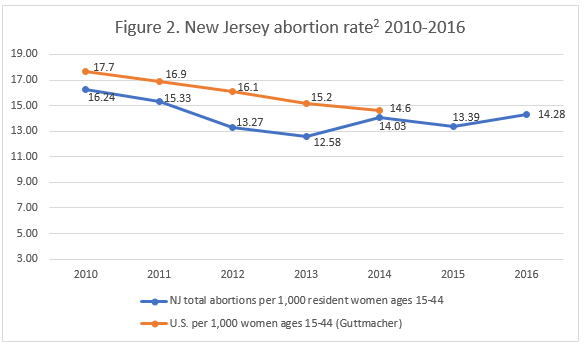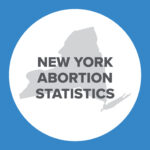Abortion Reporting: New Jersey (2016)
New Jersey’s 2016 abortion report shows that abortions in the state have increased. However, abortion reporting in the state is not mandatory for all abortion providers, meaning that abortions in the Garden State are underreported. New Jersey does not publish its abortion report online but made it available to the Charlotte Lozier Institute upon request.
Changes in New Jersey Abortions, 2015-2016

*Information on New Jersey’s state abortion report and Planned Parenthood’s New Jersey market share is not publicly available.
Abortion Totals and Trends
In 2016, there were 24,470 abortions reported in New Jersey, up six percent from the 22,991 reported in 2015 (Fig. 1). Chemical abortions increased by an even greater percentage, rising by 24 percent from 4,141 in 2015 to 5,152 in 2016. Chemical abortions made up 21 percent of all abortions reported in New Jersey in 2016. Over the longer term, however, abortion totals have been trending downward. Total abortions dropped by 14 percent from 2008, the earliest year with data available to the Charlotte Lozier Institute. Over the same time period, chemical abortions rose by 335 percent, making up four percent of all abortions in 2008 and 21 percent in 2016. New Jersey does not report the state abortion rate, but CLI estimates that the rate has increased slightly from 13.4 abortions per 1,000 women in 2015 to 14.3 in 2016 (Fig. 2).
State Report Summary
The majority of the abortions reported in New Jersey in 2016, 94 percent, were performed on residents. Four percent were performed on women from Pennsylvania, and the remaining two percent were performed on women from other states. More than half of the abortions (58 percent) were performed on women in their twenties, 29 percent on women in their thirties, and four percent on women age 40 or older. Ten percent of the abortions reported in New Jersey were performed on girls age 19 or younger, including 61 girls under the age of 15.
Black women composed the largest racial group, undergoing 41 percent of the abortions reported in New Jersey, even though black women make up only 18 percent of New Jersey’s population of women of childbearing age. Just 32 percent of the abortions were performed on white women, who make up 69 percent of the population. Nineteen percent of reported abortions were performed on women of a different race and eight percent on women of an unknown race. A high majority of women (86 percent) were unmarried, while 11 percent were married. Marital status was unknown for three percent of the women getting abortions.
Many women had experienced pregnancy before. Twenty-seven percent had one prior live birth, and 30 percent had two or more. Forty percent reported no prior births. Sixty-one percent of the women reported no previous abortions, 18 percent reported one prior abortion, and 17 percent reported two or more.
Many of the abortions reported in New Jersey were performed in the first trimester, between zero and 12 weeks of gestation. More than a third, 36 percent, occurred at six weeks of gestation or earlier. A quarter were performed between seven and eight weeks and 11 percent between nine and 10 weeks. Seven percent of reported abortions were performed between 11 and 12 weeks of gestation. Eight percent of New Jersey abortions occurred early in the second trimester, between 13 and 15 weeks, while five percent were performed between 16 and 19 weeks. There were 234 abortions performed at 20 weeks – five months of pregnancy – when babies can feel pain. Three percent, 686 abortions, were performed at 21 weeks of gestation or even later. In New Jersey, there is no limit on when an abortion may be performed; New Jersey is one of seven states plus the District of Columbia that permit abortion throughout all nine months of pregnancy without any limitation whatsoever.
Abortion Occurrence in New Jersey
In New Jersey, only licensed ambulatory surgical facilities and hospitals are required to report abortions to the state. Unlicensed facilities and private doctors are not required by law to report abortions. Because abortion reporting in New Jersey is only mandatory for certain facilities, the true number of abortions occurring in the state is unknown. A 2014 Guttmacher Institute survey of abortion providers estimated that the actual number of abortions performed in New Jersey in 2014 was 44,460 abortions, 84 percent higher than the official state total for that year, 24,181 abortions. According to Guttmacher, 4.8 percent of total U.S. abortions in 2014 were performed in New Jersey, even though U.S. Census Bureau estimates suggest that only 2.7 percent of American women of childbearing age lived in New Jersey in 2014. Guttmacher reports that only 10 percent of all U.S. counties had an abortion clinic in 2014, but in New Jersey there were abortion clinics in two-thirds of the counties.
State Ranking
The Charlotte Lozier Institute studied abortion reporting across the 50 states, the District of Columbia, and New York City, and ranked states on the quality of their reporting. New Jersey received a low score for failing to make its reports publicly available. New Jersey could improve its reporting simply by publishing abortion reports online, rather than requiring citizens to submit data requests to the health department. The state could also require all abortions to be reported, not just those performed in hospitals or ambulatory surgical facilities. Under New Jersey’s current reporting system, the true number of abortions performed in the state is unknown. New Jersey could also request more information from doctors that many other states already collect, such as whether abortions resulted in any complications. By making information on all abortions performed in the state available to researchers and citizens, New Jersey could provide a more accurate view of the state’s true abortion incidence.


- Abortion reporting in New Jersey is mandatory for hospitals and licensed ambulatory care facilities only. Abortions performed in doctor’s offices and unlicensed ambulatory care facilities are not reported. Consequently, the abortion totals reported here do not reflect all abortions performed in New Jersey.
- New Jersey does not report the state abortion rate. Rates were calculated by the Charlotte Lozier Institute using population estimates from the United States Census Bureau. The rates were calculated using the following formula: (total number of abortions performed in New Jersey ÷ number of resident women ages 15-44) x 1,000.


























